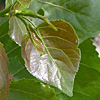Black poplar is a tall, deciduous fast-growing tree. The black poplar variety which originates in Lombardy, in northern Italy (although it is thought that it was brought there in the past from central Asia), is the most common poplar in Europe and in Israel. This variety is characterized by a narrow fastigiate crown of male trees, where the branches and their foliage cover the trunk along its entire length.
Black poplar is used first and foremost as an ornamental tree for creating boulevards or as single trees in gardens and in parks. It is a rather short-lived tree. It reaches a height of 35 m or more, and its maximal diameter at breast height can reach more than 2 m.
The bark of the mature tree is gray and scabrous, with deep furrows. Its wood is white and soft. Its forestry and agricultural uses around the world are as windbreakers and as a source of wood for the production of matches and crates. Its leaves serve as fodder for cattle. In Holland, the poplar as well as the willow, are used for the manufacture of the traditional wooden shoes.
The leaves are cordate, broad at their base and narrow into a pointed and elongated tip. They are greenish, and turn yellow in the autumn prior to their shedding.
Black poplar flowers are unisexual and it is a dioecious tree. The planted trees are usually male trees, whose fastigiate crown is very narrow. They are propagated by cuttings which preserve the traits of the father trees. The female trees have a broader crown.
The male trees have an elongated and narrow, 8 cm long, red, spike-shaped inflorescence which turns dark, they are wind pollinated. The inflorescences of the female trees dangle from the branches and are shorter and green. Bloom occurs in the early months of spring, and precedes or is concomitant with the beginning of sprouting.
The female trees produce fruits in mid-summer. The seeds are surrounded by dense downy hairs. They are dispersed by wind and are also carried by water currents.
The name of the Salicaceae family, to which the genus Populus belongs, apparently originates from Celtic, where the two-word phrase that comprises this name: “near water”, is characteristic of the habitat of trees from this family. The Latin name Populus and the English name poplar are an onomonopia, as in Hebrew (tzaftzefa), where the sound of the word imitates the whistling sound of the leaves when wind blows through them. The “black” color of the species is due to the furrows in the bark, which from a distance make the bark appear black.
The origin of black poplar is in the temperate region of central Asia. There is disagreement among researchers on whether the trees that grow in Europe and in North Africa, including the Italian variety, are native to these areas or were imported from Asia.
The poplar grows well in riparian habitats. In dryer areas, including gardens and groves in Israel, large amount of irrigation is necessary in order to sustain it and attain its rapid growth.
Black poplar is known for its medicinal utility. The Greek physician and scientist, Dioscorides noted its value in trating arthritis and gout already in the first century BCE. It is also known that diuretics and analgesics can be produced from this tree.
The genus Populus includes 25-35 deciduous trees which all grow in the cold temperate regions of the Northern Hemisphere.
In Israel, attempts were made in the 1960s to plant poplars for wood production, and some researchers and farmers even expected them to produce 8 cubic meters per dunam annually. However, in spite of extensive irrigation and fertilization which the saplings received in agricultural soil, they did not yield even one quarter of the expected production. Plots of such trees were in Yagur and Gonen.
In Israel, black poplar trees are planted as ornamental trees in public gardens and near springs and rivers. They succeed in the lowlands and the valleys, with irrigation. Black poplar is not suitable and was not planted as a tree for forestation by the KKL (Jewish National Fund).
Written by Zvi Avni






